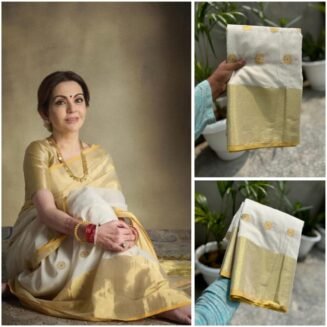Understanding the Craft: The Art of Weaving Sarees
The craft of saree weaving is a time-honored tradition steeped in history and cultural significance across various regions of India. Originating from an intricate understanding of textiles, the artistry of weaving sarees has been passed down through generations, embodying the heritage and identity of communities. Each saree reflects the unique styles, patterns, and techniques distinct to its region, offering a glimpse into the rich tapestry of Indian culture.
At the heart of this craft lies the weavers, skilled artisans who dedicate their lives to perfecting their technique. The weaving process itself involves meticulous attention to detail, requiring a profound understanding of color, texture, and design. Different weaving techniques, such as Banarasi, Kanjivaram, and Jamdani, not only showcase the weaver’s craftsmanship but also carry cultural stories and traditions that enhance the saree’s appeal. As a result, every saree that is hand-woven serves as both a piece of clothing and a narrative woven into the fabric.
Despite the enduring popularity of sarees, weavers face numerous challenges in today’s fast-paced fashion industry. Mass production and the rise of fast fashion threaten the livelihoods of these artisans and the integrity of their craftsmanship. The influx of cheaper, machine-made alternatives often overshadows traditional handmade sarees, making it increasingly difficult for weavers to find a market for their creations. Additionally, this shift undermines the cultural significance and artistry inherent in hand-woven fabrics.
In response to these challenges, online saree stores are emerging as vital platforms for artisans to connect with customers directly. By bypassing intermediaries, these stores empower weavers, enabling them to showcase their unique skills and sell their creations at reasonable prices, thereby preserving this ancient craft for future generations. An online presence allows for greater visibility, ensuring that the legacy of saree weaving continues to thrive in the modern era.
Benefits of Buying Sarees Directly from Weavers Online
Purchasing sarees directly from weavers through online platforms offers a multitude of practical advantages. One of the most significant benefits is the elimination of middlemen, which allows customers to acquire high-quality sarees at more reasonable prices. Traditionally, the saree market has involved multiple intermediaries who often inflate the prices, making it challenging for consumers to access authentic handwoven sarees. By engaging directly with weavers, shoppers not only enjoy lower costs but also foster a transparent pricing structure.
Furthermore, online saree shopping plays an essential role in supporting local artisans. Many weavers come from rural backgrounds where economic opportunities are limited. By purchasing directly from them, customers contribute to the sustenance of traditional crafts and support the livelihoods of these skilled artisans. This connection between consumers and weavers is crucial in preserving unique weaving techniques and cultural heritage, ensuring that these practices are passed down through generations.
Aside from supporting local economies, direct purchases promote sustainability and ethical fashion. Many weavers adopt environmentally friendly practices that reduce waste and often use natural dyes, which are less harmful to the ecosystem compared to synthetic alternatives. By choosing to buy from weavers, consumers can make informed choices that align with their values and contribute to a more sustainable fashion industry.
For those interested in navigating the online saree shopping experience responsibly, it is vital to research vendors. Look for reputable online stores that provide detailed information about the weavers and their crafts. Authenticity can often be verified through customer reviews, certifications, and transparency regarding sourcing. By actively seeking information and supporting ethical practices, consumers can greatly enhance their online weaving purchases while appreciating the art and craftsmanship that goes into every saree.







